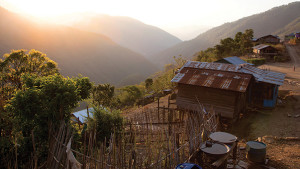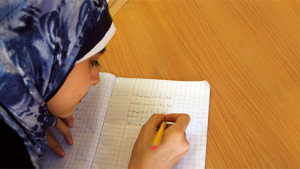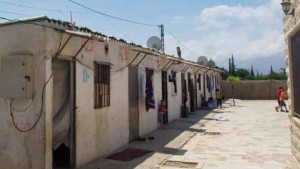T
here's a stranger in her kitchen and three-year-old Meita doesn’t welcome the intrusion. Eating a bowl of rice with her mother and six sisters in their rugged kitchen, Meita’s round cheeks are painted with thanakha—pale yellow paste traditionally worn by women and girls in Myanmar (Burma). Her eyes are wide and she is wary of our presence.
Foreigners are rare in the remote wilderness of the Chin State.1 We are a gruelling 140km drive from the nearest major township. It's unlikely Meita has ever seen faces as pale as ours.
She is too young to understand why we are here; to comprehend her tumultuous history; to relish growing up in the freedom that is now possible in a democratic Myanmar; or to understand that, like 70 per cent of the half a million people of Chin State, she and her family are living below the poverty line.
A lack of income-earning opportunities has led to one in three residents moving away to find work. The narrow road to their village was etched into the side of the mountains by the villagers through a food-for-work program funded by the Adventist Development and Relief Agency (ADRA) and the World Food Program (WFP).
Meita’s home is simple. The only furniture is a low table at which they eat breakfast, and tiny timber platforms they use as stools. There is a small room for sleeping and an unfinished upper level that doesn’t yet have floorboards.
We are here to interview Meita’s father, Re Bik Thang—a participant in ADRA’s Poverty Reduction Initiative and Community Empowerment (PRICE) Project. Traditionally proud hunters, the older generation of Chin men adorn their houses with animal skulls, showcasing their masculinity. But Bik Thang is not so bold. As a farmer, he works with his wife to clear and cultivate the communal land, growing maize, legumes and elephant foot yam, a valuable export crop. They also grow rice on terraced land along the riverbanks and raise the hardy mountain mithun cow in the surrounding forest.
Last year, Tropical Cyclone Komen ravaged the region, causing widespread flooding and landslides. Tonnes of rock and sand washed down the valley, burying up to 80 per cent of the terraced land.
“Since the floods and heavy rain we have no more place to plant rice paddies,” Bik Thang laments. “It’s really difficult for our family to survive because there is no terrace anymore. We tried to clear the sand but it was too hard.”
His wife is gentle and sweet but we squirm on our little stools when her comment is translated. “The lack of money means we haven’t been able to finish building a house,” she says. “Sometimes I feel angry at my husband for not being able to provide enough for our family.”
This poverty has many dimensions—low levels of education, lack of family planning, insufficient nutrition, inadequate housing, unsustainable agricultural approaches—each compounded by the devastation of natural disaster.
My thoughts shift to little Meita. What does the future hold for this little girl and her sisters? Will she get adequate nutrition or will her growth be stunted like one-third of all children living in Myanmar?
Without a strong local economy it’s likely that she will have to move away to find work in the distant towns and cities. She may have to migrate to Malaysia or further afield to gain low-paid work as an unskilled factory worker, labourer or housekeeper. It's a less threatening prospect than that faced by tens of thousands of Chin who fled as refugees prior to 2012 following decades of conflict and insecurity.2
ADRA’s PRICE Project is working with villagers to improve living standards for children like Meita and her family. Following extensive community consultation, the project was designed to focus on agricultural development, natural resource management and village infrastructure development.
PRICE is match-funded by the Australian Government NGO Co-operation Program (ANCP) and private donations from Australians.
Villagers told us that no other non-government organisation (NGO) operates in this remote region of Chin State, so it is no surprise the local people value ADRA so deeply. Local community mobilisers form Self-Help Groups (SHGs) to organise training and establish savings and loans groups to improve cash circulation in the local economy.
Borrowing funds through the SHG has enabled Bik Thang to purchase a mithun cow and elephant foot yam seeds, helping him to earn more income to support his family, reducing the likelihood of seasonal food shortages and increasing resilience in the face of disasters.
I am proud of my government and the selfless strangers who have donated funds to help these beautiful people.
On my flight home, I come across a quote from Burmese Nobel Peace Prize winner Aung San Suu Kyi. “It takes courage to lift one’s eyes up from their own needs and to see the truth of the world around them . . . It takes even more courage not to turn away, to make excuses for non-involvement or to be corrupted by fear. It takes courage to feel the truth, to feel one’s conscience. Because once you do you must engage your fundamental purpose for being alive. You can’t just expect to sit idly by and have freedom handed to you.”
As I stare out the window at the clouds, I imagine a 30-year-old Meita teaching a group of pale-faced foreigners about the history of her people and how they rose to be truly free.
Help restore hope for people like Meita today. Visit <adra.org.au/restore>.
1. Bordering India, Chin State is in north-western Myanmar. The mountainous state occupies territory about the size of Switzerland and has an average elevation close to that of Australia's Mt Kosciuszko. Predominantly a Christian state, it is home to around half a million people and is one of the most isolated, underdeveloped and poverty-stricken states in Myanmar.
2. The Chin People of Burma: Unsafe in Burma, Unprotected in India; Human Rights Watch, https://www.hrw.org/sites/default/files/reports/burma0109web_0.pdf
Janelle Muller is marketing director at ADRA Australia.





